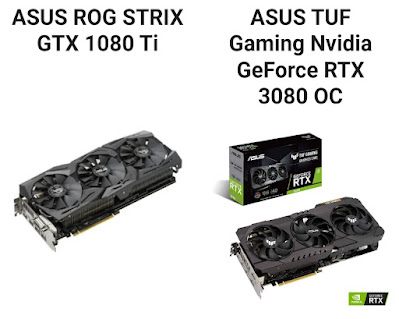There are many different brands available, Nvidia is one of the most popular to choose from. If you have decided to purchase an Nvidia GPU, you have likely come across two popular Geforce series – RTX and GTX graphics cards.
If you are new to gaming you may be unsure of the differences and similarities between the two. We have discussed both series of GPUs in more detail, focusing on the differences in specifications and the similarities, such as price, ray tracing, and architecture.
While these two models of GPU are seemingly similar they do have a few significant differences.
Price
The first difference between both GPUs are the price. RTX graphics card series are newer models in comparison to GTX graphics card series. Given this, they do tend to be more expensive.
They are typically around a few hundred dollars more expensive depending on the model you choose. The price increase is understandable given that they are more recent and do have additional features.
However, in many cases, their performance is not hugely different overall. While the RTX graphics card series does produce better graphics, both series are not vastly different. When discussing the price, it is worth noting that both of these GPU series are high-end. Given this, they are more expensive in comparison to the entry-level GPUs. The price is reflected in the better specifications, however.
Architecture
The architecture of a GPU is important and encompasses how well the graphics cards will perform in-game. It covers aspects such as clock speeds, performance, and what the graphics cards are like on the whole. When it comes to the architecture for RTX and GTX graphics card series, there are surprisingly little difference between them both. When looking at the newer models, both use Nvidia Turing architecture. This is created specifically for the newer Nvidia series and is currently the best architecture available. Nvidia Turing provides far better performance in comparison to older Nvidia GPUs. It runs quieter and cooler overall. It has a 1.4X better power efficiency in comparison to previous models and the graphics provided are particularly great.
While the majority of GTX graphics card series do use Nvidia Turing architecture, the older series, like the 1060 for example uses Nvidia Pascal. While this architecture is good, it does not provide as good a performance in comparison to the RTX graphics card series. The RTX graphics card models in general have better cores and clock performances which allow the performance in-game to be better than the GTX graphics card series. They also feature Nvidia DLSS and ray-tracing cores, which the GTX does not.
Ray Tracing and RT Cores
The ray-tracing capabilities of the Nvidia RTX graphics card series are what sets it apart from the GTX graphics card series. While you can play games successfully without ray tracing, these features allow the graphics in-game to become more realistic. The shading and lighting are far better when ray tracing is in use. While many GPUs are capable of ray tracing, the RTX graphics card series features hardware dedicated to this purpose.
This hardware does not slow down gameplay and the ray tracing is 6X faster than on any other GPU. The ray tracing in real-time, and the RTX graphics card series are currently the only GPUs to include RT cores. In addition to the RT cores, it features Tensor cores too. The Tensor cores provide clearer and crisper graphics overall. Ray tracing is particularly useful if you play a lot of next-gen or AAA games. While it is not necessary, it will improve the graphics overall and you are likely to see this difference.
Futureproofing
When it comes to futureproofing, the RTX graphics card series does have the edge over the GTX graphics card series, but only by a close margin.
While they both feature the newest architecture, the ray-tracing capabilities of the RTX graphics card series do make it slightly more future-proof, especially when it comes to playing newer next-gen games. It is worth noting that all RTX and graphics card models feature a PCIe 3.0 interface. This was an interesting choice by Nvidia. While PCIe 3.0 is still the most used interface, PCIe 4.0 has been introduced.
Eventually, PCIe 3.0 will likely be phased out and replaced with PCIe 4.0. Both types of GPU are capable of 1440p and 4K gaming, though 1080p remains the most common gaming resolution. It is worth noting that the newer GTX graphics card series will allow for a higher gaming resolution in comparison to the older GTX graphics card series.
All of the RTX graphics card series use GDDR6 VRAM. This is currently the best available as GDDR7 is yet to be announced. While some of the GTX graphics card series uses GDDR6, the older GTX graphics card models such as the 1060 use GDDR5. Given this, unless you choose a GTX graphics card series with GDDR6, the RTX graphics card series would be the better VRAM option.
Is the RTX graphics card series A Marketing Ploy
This question is often debated within the gaming community and is down to personal opinion. If you play a lot of games that would benefit from real-time ray tracing, the RTX graphics card series is certainly for you.
However, the higher-spec GTX GPUs are very similar to the RTX in performance. When looking at the benchmarking and fps results for both types of GPU the difference with the newer GTX graphics card models is minimal. Given this, if you are shopping on a budget and are not bothered about the ray tracing of DLSS capabilities, then perhaps the GTX graphics card models would be the better option for you.
Conclusion
To conclude, overall the RTX GPUs are the better choice when you take into consideration futureproofing, specifications, and performance. However, the newer GTX graphics card models are not too dissimilar, but they do not feature ray tracing or DLSS capabilities. Both models of graphics cards are great choices and are worth investing in. They perform well in-game and provide excellent graphics overall. While the RTX graphics card series is slightly better overall, it does come at an increased cost in comparison to the GTX graphics card series.



















